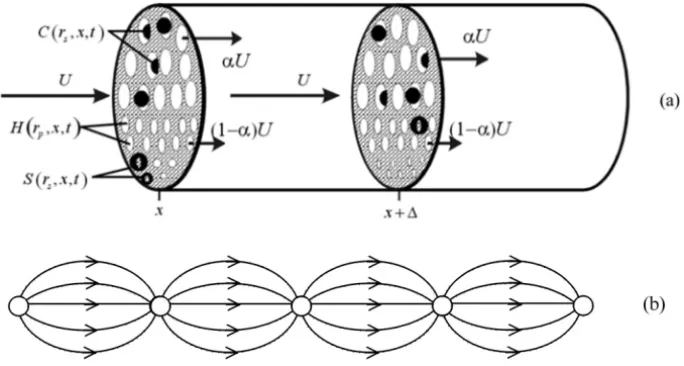Volume 24, N. 3, pp. 491–495, 2005 Copyright © 2005 SBMAC ISSN 0101-8205
www.scielo.br/cam
Erratum:
(Computational and Applied Mathematics, Vol. 23, N. 2-3, pp. 259–284)
Size exclusion during particle suspension
transport in porous media: stochastic
and averaged equations
A. SANTOS1 and P. BEDRIKOVETSKY2
1Universidade Católica do Rio de Janeiro (PUC-Rio/DEC/GTEP) Rua Marques de São Vicente 225, 22453-900 Rio de Janeiro, RJ, Brazil
2Universidade Estadual do Norte Fluminense (UENF/LENEP) Rod. Amaral Peixoto, km 163 – Av. Brenand s/n.
27925-310 Macaé, RJ, Brazil
E-mails: asantos@civ.puc-rio.br / pavel@lenep.uenf.br
Abstract.
A pore scale population balance model is formulated for deep bed filtration of stableparticulate suspensions in porous media. The particle capture from the suspension by the rock
occurs by the size exclusion mechanism. The equations for particle and pore size distributions
have been derived from the stochasticMaster equation. The model proposed is a generalization
of stochastic Sharma-Yortsos equations – it accounts for particle flux reduction due to restriction
for large particles to move via small pores. Analytical solution for low particle concentration is
obtained for any particle and pore size distributions. The averaged macro scale equations, derived
from the stochastic pore scale model, significantly differ from the traditional deep bed filtration
model.
Mathematical subject classification:
76S05, 60H15.Key words:
deep bed filtration, particle size distribution, pore size distribution, size exclusionmechanism, stochastic model, averaging.
492 ERRATUM: STOCHASTIC AND AVERAGED EQUATIONS
Figure 1 – Geometric model of the porous medium (a) Sketch for particulate suspension transport in porous media: particles are captured due to size exclusion. (b) Connectivity in the porous medium model.
A. SANTOS and P. BEDRIKOVETSKY 493
Figure 4 – Concentration waves for different particle sizes. Each front moves with velocityα(rs). Line 1 corresponds to transport of small particles (rs1 <rpmi n). Lines
2 and 3 are related to filtration of intermediate size particles,rs2 <rs3. Line 4 shows
the large particle concentration (rs4>rpmax).
Figure 5 – Concentration distributions for suspended particles and vacant pores during filtration: (a) initial distributions; (b) distributions behind the concentration front for
494 ERRATUM: STOCHASTIC AND AVERAGED EQUATIONS
Figure 6 – Suspended concentration at the core outlet. Lines 1 and 3 are related to large and small particles, respectively. Line 2 corresponds to intermediate size particle concentration.
A. SANTOS and P. BEDRIKOVETSKY 495



